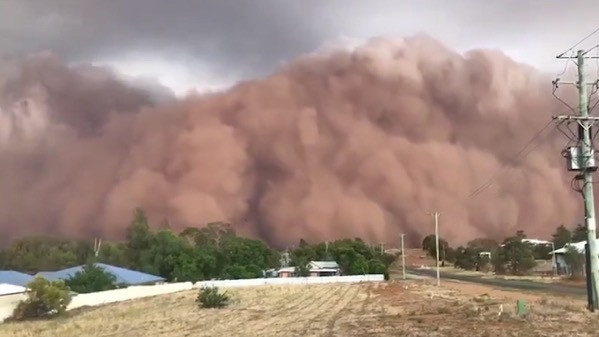
In 1908 the Australian poet, Dorothea MacKellar wrote her famous Poem ‘My Country’, while she was feeling homesick on a trip to England. It is an over romanticised piece about Australia and its weather, but it t is now an iconic poem and a significant part of Australia’s folklore.
It is the second verse that quite accurately represents the weather and climate we have experienced in Melbourne through January
The love of field and coppice
Of green and shaded lanes,
Of ordered woods and gardens
Is running in your veins.
Strong love of grey-blue distance,
Brown streams and soft, dim skies
I know, but cannot share it,
My love is otherwise.
I love a sunburnt country,
A land of sweeping plains,
Of ragged mountain ranges,
Of droughts and flooding rains.
I love her far horizons,
I love her jewel-sea,
Her beauty and her terror
The wide brown land for me!
The stark white ring-barked forests,
All tragic to the moon,
The sapphire-misted mountains,
The hot gold hush of noon,
Green tangle of the brushes
Where lithe lianas coil,
And orchids deck the tree-tops,
And ferns the warm dark soil.
Core of my heart, my country!
Her pitiless blue sky,
When, sick at heart, around us
We see the cattle die
But then the grey clouds gather,
And we can bless again
The drumming of an army,
The steady soaking rain.
Core of my heart, my country!
Land of the rainbow gold,
For flood and fire and famine
She pays us back threefold.
Over the thirsty paddocks,
Watch, after many days,
The filmy veil of greenness
That thickens as we gaze …
An opal-hearted country,
A wilful, lavish land
All you who have not loved her,
You will not understand
though Earth holds many splendours,
Wherever I may die,
I know to what brown country
My homing thoughts will fly.
The first part of January was very hot in Melbourne with temperatures of over 40C. We had bushfire smoke around the city that irritated one’s eyes and made it difficult for many to breath. It reduced visibility to just a few hundred metres. The smoke came from extensive bushfires that extended right up the east coast of Australia. Somehow, only 28 people have died but 2000 homes have been lost. Communities were evacuated – one by navy ships – and the military were evacuating people from isolated farms and settlements by helicopter. Many of these fires are still burning and they have burnt out an area about the size of the State of Tennessee in America.
I believe that many fires are still burning although recent rain has helped to contain them. Firefighters have been actively working on them since early November.
At the height of the fires, the sky was full of haze and the view out our window looked like this.

Then one day, overnight we had a cool change that brought the first rain since November. Would you believe that the daily maximum temperature fell to just 13C and we turned our heaters on! You could have mistaken the smoke haze for a foggy winter’s day – except for the smell.
The second and third weeks of the month were still a little smoky, but more like the weather we would expect at this time of the year – warm to hot.
Last weekend, we had a different type of weather incident – a sever thunderstorm cell that dropped around 45 mm ( nearly two inches) of rain in just 20 minutes. We survived without much damage at our place, other than my workshop being flooded, but our local supermarket was inundated with water when the roof collapsed under the weight of the water. We were lucky that we only had hailstones as large as marbles here. A few suburbs away, they were as big as golf balls.

This morning, we woke, scratching our heads, at orange mud over everything and sludge-coated cars, clothes and outdoor furniture.

A cold front had passed over the state during the night bringing more rain and pushing a giant dust storm in front of it.

Dust storms are are regular occurrences for people living in the centre of Australia. A combination of drought and severe weather patterns this summer has meant that they are happening more frequently. These phenomena occur when the soil in Outback Australia is barren and dry. Strong winds of over 30 km per hour pick up the soil and carry it across long distances.
So, from drought over the last few years, we have suddenly moved on to Dorothea MacKellar’s ‘flooding rains’. The latest rain events have pushed Melbourne’s January’s rainfall to more than 110 millimetres, more than double the month’s average total of 46 millimetres, and we still have a week to go.
I do love a sunburnt country, but I could do without the extremes of drought and flooding rains!



Thanks, Bruce, for such a great description of our recent weather experiences! I had our villa windows cleaned and two days later the dust-storm undid all the work! Small price to pay compared to the devastation of so many homes and properties, the loss of lives and of stock and wildlife, as well as land degradation. Mackellar’s poem certainly encapsulates the nature of Australia! Kind wishes to you and yours.
Your comments have reminded us that we should be a world community of love, concern and prayers. It is no longer an event reported on world news, but rather it is the reality of personal friends. You are on the prayer list of “your home church in Western North Carolina.”
The past months have certainly brought the poem to real life for so many. For many of our generation and maybe those who follow, it is the one verse we have never forgotten.